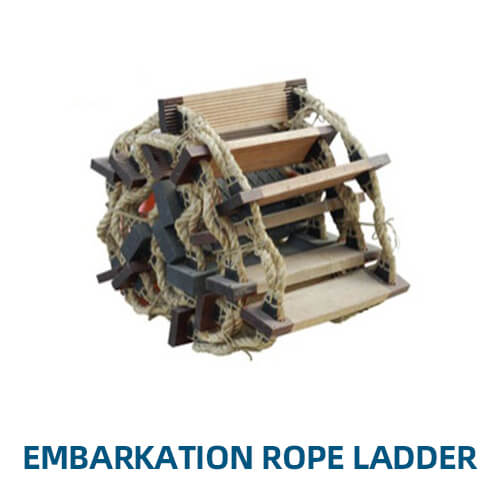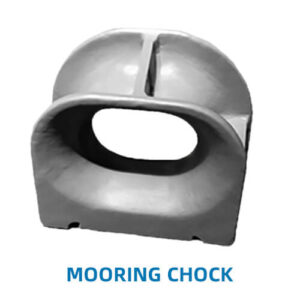Key Features of an Embarkation Rope Ladder:
- Construction and Materials:
- Rope Sides: The ladder features strong, durable rope sides, often made from natural fibers like manila or synthetic materials such as polyester, which are resistant to weathering, UV radiation, and saltwater corrosion.
- Rigid Rungs: The rungs of the ladder are typically made from wood, aluminum, or synthetic materials. They are spaced evenly along the rope sides to provide stable footing.
- Non-Slip Surface: To prevent slipping, especially in wet conditions, the rungs may have a textured or grooved surface.
- Design and Functionality:
- Flexible Design: The rope ladder is highly flexible, allowing it to be easily rolled up for storage and quickly unrolled when needed. Its flexibility also enables it to conform to the shape of the ship’s hull when deployed.
- Lightweight: Designed to be lightweight for ease of handling and rapid deployment in emergencies.
- Length: The length of the ladder can vary depending on the ship’s size and the height from the deck to the waterline. Some ladders can be several meters long to ensure they reach the water in all sea conditions.
- Safety Features:
- Strong Construction: Embarkation rope ladders are built to support the weight of multiple people at once, ensuring safe and reliable use during an emergency evacuation.
- Stowage: The ladder is typically stored in a ready-to-deploy position near emergency exits, such as lifeboat stations, to facilitate quick access during an emergency.
- Safety Certificates: These ladders are often certified to meet international safety standards, such as those outlined by the International Maritime Organization (IMO) and the Safety of Life at Sea (SOLAS) convention.
- Applications:
- Emergency Evacuation: Primarily used during emergency situations where the crew and passengers must abandon ship. The ladder allows for safe descent from the deck to the water or to lifeboats.
- Boarding and Disembarking: In situations where gangways are unavailable or impractical, the rope ladder can be used for boarding or disembarking from the ship to smaller boats or docks.
- Pilot Boarding: Although less common than specialized pilot ladders, embarkation rope ladders can be used for pilot transfers in certain situations.
- Deployment:
- Quick Release: The ladder is designed to be quickly released and deployed, often with a simple untying or release mechanism that allows it to drop over the side of the ship.
- Securing Points: The ladder is securely attached to strong points on the ship, usually near the deck edge or lifeboat stations, ensuring it remains firmly in place when in use.
- Maintenance and Inspection:
- Regular Inspections: To ensure the ladder remains in good working condition, it must be regularly inspected for signs of wear, damage, or degradation, particularly in the ropes and rungs.
- Storage Conditions: The ladder should be stored in a dry, protected location to prevent damage from exposure to the elements. Proper storage ensures the ladder remains ready for use at all times.
Advantages of an Embarkation Rope Ladder:
- Emergency Preparedness: Provides a reliable means of evacuation in emergencies, essential for safety at sea.
- Versatility: Can be used in a variety of situations where conventional ladders are impractical.
- Durability: Built to withstand the harsh marine environment, offering long-term reliability.
Considerations When Using an Embarkation Rope Ladder:
- Proper Training: Crew members should be trained in the correct deployment and use of the ladder to ensure safe and efficient evacuations.
- Condition of the Ladder: Regular inspections and maintenance are crucial to ensure that the ladder remains safe to use, especially since it may be stored for long periods without use.
- Accessibility: The ladder should be stored in an easily accessible location, with clear instructions for deployment.
The Embarkation Rope Ladder is an essential piece of safety equipment on ships, designed to facilitate safe evacuation during emergencies and to provide access when traditional methods are unavailable. Its robust construction, ease of deployment, and adherence to safety standards make it a vital component of a ship’s emergency preparedness plan. Whether used in an emergency to abandon ship or for boarding in challenging conditions, the embarkation rope ladder is a reliable and necessary tool for ensuring the safety of all aboard.






